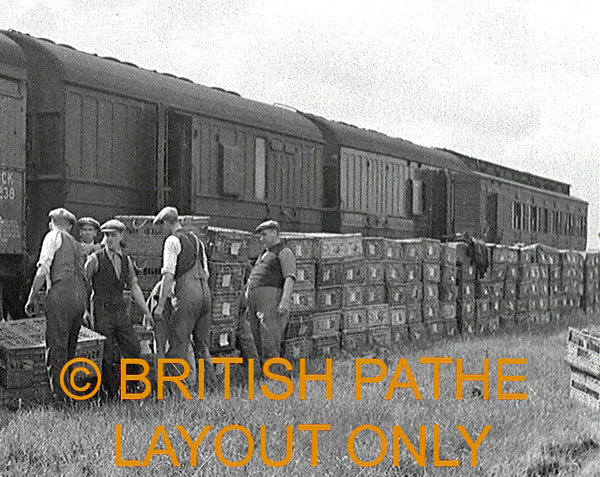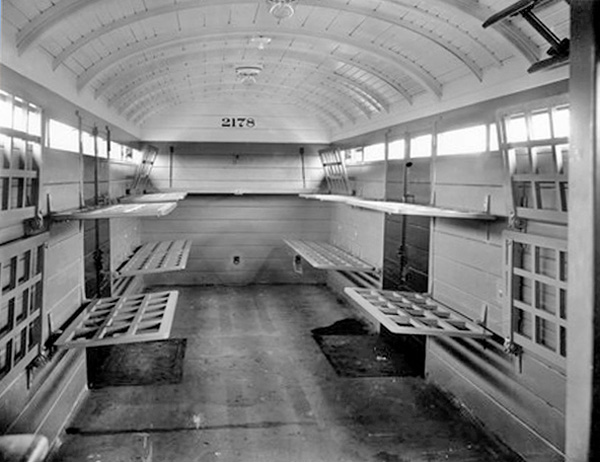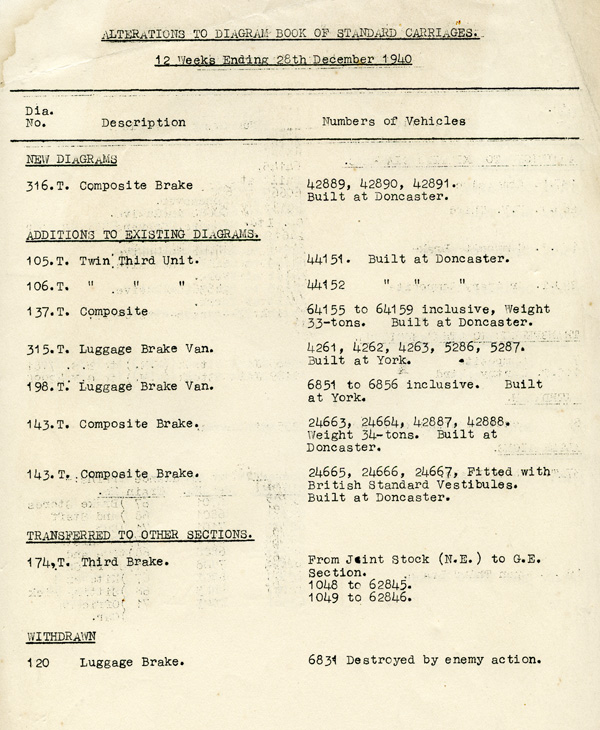Pigeon traffic
Pigeon traffic and its vehicles is destined for publication, meanwhile here are some illustrations that touch on what actually happened and the myth that LNER bogie and 4w "pigeon vans" were built in large numbers for East Anglia. Hence the following is mostly LNER/ER, and some LMS/LMR as it comes to hand.
It is convenient to begin with precursors on the NE Area that show in specials from the North East:

This still from a Pathe-News film shows a Homing Pigeon Race Special from the NE at Selby in 1934. Note the carriage on the rear for Federation officials, called convoyers, and the ex-NER 6w passenger brake vans, many of which were fitted with shelves for the pigeon traffic. Just visible is a corner of a bogie CCT which was equipped the same way (LNER Code 8003).

Another Pathe still of a Pigeon Special from the North Eastern Area at Selby, this one in 1936. All the vehicles in the stills from this event are ex-NER, bogie and 6w - except for the one next to the loco, No 2199, which is one of the LNER quartet of 51'1 1/2" vans supplied in 1928 with drop-down shelves specially for this traffic. Note the normal arrangement of toplights, almost entirely sealed, unlike the opening ones in the vans supplied to East Anglia with fruit & veg traffic in mind (see also interior views below).

This is an LNER Official (courtesy the NRM) of the interior of bogie van No 2178, one of the aforementioned quartet of 51'1 1/2" BV built in 1928. The drop-down shelves are evident, and the almost entirely sealed toplights. No more bogie pigeon vans were built until 1938 when construction began of the gangwayed 61'6" version.
Modifications for general and fruit and veg traffic
A revised version of D.129 (and the 4w vans to D.120) were subsequently built for East Anglia with similar shelves - but with different ventilation because they were neither designed, built nor used for homing pigeon traffic but fruit and veg for which there had been a long-standing need and use since GER days. The new construction was modernisation in the usual like-for-like allowed the predecessors to be scrapped. The "pigeon van" myth is caused by misunderstanding of the wording on the Diagrams and disregard for the design parameters and the actual use of these vehicles in traffic.

This interior view from a GE Section bogie van intended for fruit and veg traffic shows the drop-down shelves and improved ventilation via the opening end three toplights: the clasp/hinge arrangement is clearly visible. It was unique to the non-gangwayed vans - bogie and 4w D.120 - supplied to the GE Section.
Unfortunately, none of the D.120 kits includes these opening toplights: they all have entirely sealed toplights! Which means that the sides actually portray the Doncaster-built D.170 et al series... amid so much confusion about the design and deployment of these vans all the kit makers and reviewers missed this: there's two big write-ups from yours truly to follow.

From a pile of original documents "Alterations to Diagram Book of Standard Carriages" here is the one for the last quarter of 1940. The four parts should speak for themselves and I've put it up to show how three van diagrams were titled "Luggage brake van" for the bogie ones and "Luggage brake" for the 4w D.120. No sign of a pigeon van here!

J36 No 65294 stands at Kintore with a train for the Alford branch and a D.120 van never intended to carry pigeon traffic but to modernise older stock by replacement. Five were built for the Great North of Scotland Section to replace elderly pre-Grouping vans in general traffic, soon raised to ten by cascading from East Anglia.

Another example of modernisation of old stock vans was in the "Banbury Motor", the nickname for the local service between Woodford & Hinton (later Woodford Halse) and Banbury General. It became the practice to roster a van as a permanent part of the formation and when the D.120 series became available, the pre-Grouping ex-GCR van was eliminated. Next to it is an ex-GCR clerestory carriage. Alas, no more of the train is visible. Seen at Banbury in 1939 behind N1 No 4588.
Back to the pigeon traffic

This pair of Ogdens cigarette cards links to the Pathe-News clips. Sharp-eyed viewers will note that the vans in view are the standard ex-NER 6w passenger brake van and that shelves have been fitted. These cards were based on Patthe-News footage of another pigeon special. Ex-NER 6w vans fitted with shelves for the race special continued to be after WW2.
Now for some real workings:

This extract from a 1939 Excursion and Special Train Arrangements notice shows a working which took a van carrying pigeons overnight from Norwich to the North East. The Telegraphic Code quoted was for a conventional, ex-GER 6-wheel passenger brake van. At Peterborough, it was attached to a Down train for the north.

Two more workings from 1939, actually, a week before the one above with several similarities. Note how in both cases the Telegraphic Code "XP" was used, indicating a 6-wheel vehicle to carry pigeons.
The first working shown was from Harrogate and described as two pigeon vans, bogie (type unknown: it could have been one of the NE Area's quartet to D.129, or the earlier bogie CCT mentioned above) and the 6w version, of which the NE Section, uniquely, had many 6-wheel passenger brake vans fitted with shelves for the traffic, as already described above. These two vans began their journey in unknown manner from Harrogate to Leeds Central, where they were attached to a heavy overnight pigeon race special for the south, and dropped off at Newark. A little later, an early morning passenger train from Newark to Grantham delivered the two vans to their final destination for release of the birds. A good example, this, for modellers of a minor line.
The second working was from Norwich and almost identical to the one shown in the previous illustration but this time, like the working from Harrogate, the requirement was coded "XP", probably by the same clerk. On the GE Section the meaning would have been perfectly clear: a requirement for a 6w van to carry pigeons and it would have been met by a conventional ex-GER 6w passenger brake van with the baskets on the floor. These two listings for Norwich are instructive for in neither case was an LNER-built 4w passenger brake van - the D.120 type which some people wrongly call a "pigeon van" - specified.
Moreover, the use of "XV" and "XP" reflects a point I have made before, that human bureaucracy can be imperfect or flexible and confusing to the outsider, yet it succeeded perfectly well in conveying its meaning to people on the ground.

To underline some of the above, this is a detail view of the roster for two homing pigeon race specials from the same period in 1939 that ran from the NE Area onto the GN Section, the first to Retford, the second to Grantham, both popular release points for large races. Note how both trains were rostered exclusively for ex-NER 6w passenger brake vans fitted with shelves, and the sheer numbers of them! Despite allocation to the NE Area of fourteen 61'6" BGs with drop-down shelves (which are wrongly described by Harris as "principally" for racing pigeon traffic), 6w vans continued to dominate the traffic, even in the 1940s. The 3rd Brake on the rear was for the convoyers.

This is an LMS scene at an unidentified station. Release is taking place for a Homing Pigeon Race - from a passenger platform where there were no overhead obstructions, such as electric or lighting wires. The stock in view was the standard LMS 50ft BG, which was the norm, along with similar pre-Grouping vans, ex-LNWR, for example. The baskets would have been stacked on the floor. As far as I know, only the LNER built vans with drop-down shelves for this traffic.

This is not quite a new picture for it already appears in the topic about Bradford-King's Cross portions in West Riding Expresses - and shows N1 69474 at Wakefield on 16th August 1957. However this was a Friday afternoon at the height of the season and a homing pigeon special was due to run that night, probably starting from Leeds Central for destinations to the south. An enormous number of baskets had already been delivered by the owners and placed on the Up platform under an awning, out of the rain. Photo: P.H. Groom
- click on the picture for an enlargement

A marvellous view at East Croydon on 4th June 1965 of a homing pigeon special from Newcastle-Hove, which had had a loco change en-route with 8F No 48544 from Willesden.
The roster called for 15 BGP, BG, SK. The BGP code could be met by the Gresley teak-panelled BG with drop-down shelves (eg. D.245) but inspection of the picture shows inclusion of other varieties of LNER BG, in which the pigeon baskets would have been placed on the floor - a fine example of a vehicle being provided that could do the job required. The (BG,SK) pair on the rear cannot be seen and comes across as carrying a substantial team of convoyers and their luggage.
There's another story behind this working for by 1965 steam haulage on the Brighton line had all but disappeared: something like a Class 73 would have taken the train. A ruse of loco-shortage was played by an individual in Control, enabling this superb picture to be taken. (Photo: Charlie Verrall).
A chapter titled "The pigeon traffic" will appear in the second volume of "LNER Passenger Trains and Formations" Steve Banks & Clive Carter with a greater variety of the traffic than I can cover here.


